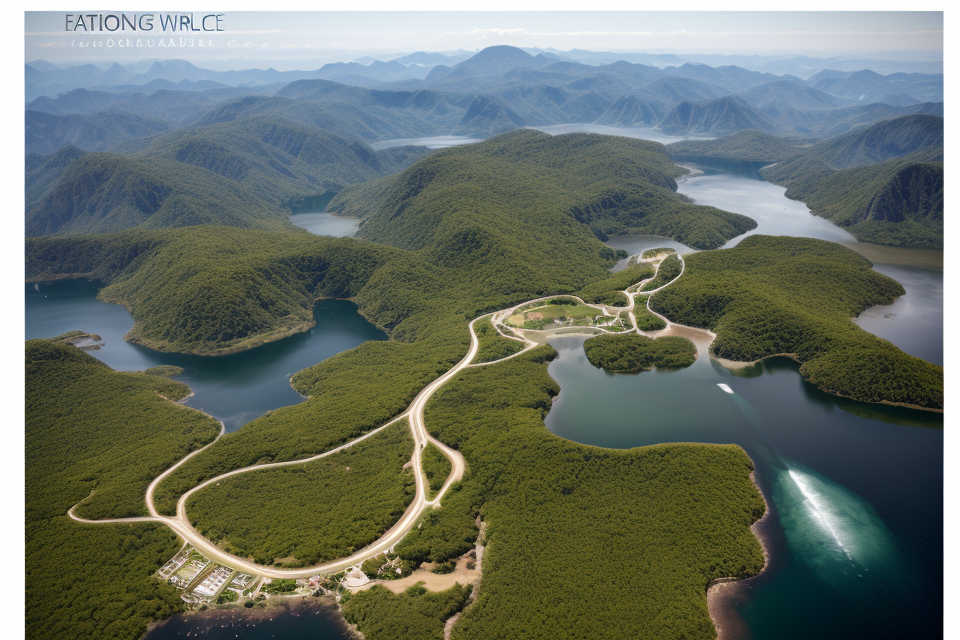Cultural heritage locations are sites, buildings, landscapes, and artifacts that have cultural, historical, or scientific significance. These locations hold valuable information about a society’s traditions, beliefs, and values, and serve as a link to the past. Cultural heritage sites are not only important for preserving history but also for promoting cultural diversity and understanding. In this guide, we will explore the significance of cultural heritage locations and how they contribute to our understanding of the world around us. We will also discuss the challenges and opportunities in preserving and promoting these valuable cultural assets.
Understanding Cultural Heritage Locations
Definition of Cultural Heritage Locations
Cultural heritage locations refer to physical spaces, such as buildings, monuments, and landscapes, that have cultural significance and are recognized as valuable for their historical, cultural, or aesthetic importance. These locations serve as tangible representations of a community’s history, traditions, and values, and often provide a window into the past, allowing people to understand and appreciate the experiences and perspectives of those who came before them.
Cultural heritage locations can encompass a wide range of sites, including historic buildings, archaeological sites, museums, religious buildings, and natural landmarks. These sites can be found in urban and rural areas and can vary in size, from small, local landmarks to large, internationally recognized heritage sites.
The cultural significance of these locations lies in their ability to connect people to their shared past and to provide a sense of continuity and identity. By preserving and celebrating these cultural heritage sites, communities can maintain a connection to their history and traditions, fostering a sense of belonging and cultural pride.
In addition to their cultural and historical value, cultural heritage locations also play an important role in tourism and economic development. Many cultural heritage sites attract visitors from around the world, contributing to the local economy and creating jobs and income opportunities. However, it is important to ensure that the preservation and promotion of these sites is done in a responsible and sustainable manner, taking into account the needs and interests of both local communities and visitors.
Types of Cultural Heritage Locations
Cultural heritage locations are sites, buildings, landscapes, and traditions that hold significant cultural value and represent the historical, social, and cultural identity of a community or society. There are four main types of cultural heritage locations: natural heritage sites, cultural landscapes, historic sites, and intangible cultural heritage.
Natural Heritage Sites
Natural heritage sites are places of unique and rare natural features, such as national parks, wildlife sanctuaries, and natural monuments. These sites preserve the biodiversity and ecological balance of the region and offer opportunities for scientific research, education, and recreation. Natural heritage sites are important for the conservation of endangered species, the preservation of ecosystems, and the protection of natural resources.
Cultural Landscapes
Cultural landscapes are areas that reflect the interaction between people and the natural environment over time. They include farmland, gardens, parks, and urban spaces that have been shaped by human activities and reflect the cultural traditions and values of a community. Cultural landscapes provide a sense of place and identity, promote cultural diversity, and contribute to the sustainable development of the region.
Historic Sites
Historic sites are places that have significant historical, architectural, or cultural value and offer insights into the past and the development of a community or society. Historic sites include monuments, buildings, museums, and archaeological sites that have been preserved for their cultural and historical significance. These sites offer opportunities for education, tourism, and cultural exchange and help to promote a sense of national identity and pride.
Intangible Cultural Heritage
Intangible cultural heritage refers to the practices, traditions, and knowledge that are transmitted orally or through demonstration and are essential to the cultural identity of a community. These include festivals, ceremonies, music, dance, stories, and crafts that reflect the unique cultural traditions and values of a community. Intangible cultural heritage provides a sense of continuity and identity, promotes cultural diversity, and helps to preserve the cultural heritage of a community for future generations.
The Importance of Preserving Cultural Heritage Locations
Significance of Preservation
Maintaining Cultural Identity
Cultural heritage locations are essential in maintaining the cultural identity of a community. These places are often associated with the history, traditions, and values of a community, and preserving them helps to maintain a sense of continuity and belonging. By preserving cultural heritage locations, communities can keep their cultural traditions alive and pass them down to future generations.
Promoting Sustainable Development
Preserving cultural heritage locations can also promote sustainable development. These places often have historical, architectural, or environmental significance, and preserving them can help to protect the unique characteristics of a place. This can help to promote sustainable development by preserving the unique qualities of a place and preventing the homogenization of communities.
Supporting Local Communities
Preserving cultural heritage locations can also support local communities. These places are often associated with the history and culture of a community, and preserving them can help to promote tourism and economic development. By preserving cultural heritage locations, communities can attract tourists and visitors, which can help to support local businesses and create jobs. Additionally, preserving these places can help to foster a sense of pride and community among residents.
Challenges in Preserving Cultural Heritage Locations
Lack of Funding
One of the significant challenges in preserving cultural heritage locations is the lack of funding. Many cultural heritage sites are located in developing countries that have limited financial resources. As a result, these sites are often left to deteriorate due to a lack of funding for their preservation and maintenance. This lack of funding can lead to neglect, which can cause irreparable damage to these important cultural sites.
Neglect and Deterioration
Neglect and deterioration are also significant challenges in preserving cultural heritage locations. Many cultural heritage sites are not given the attention they deserve, and they are often left to decay. This neglect can be due to a lack of awareness about the importance of preserving these sites or a lack of resources to maintain them. As a result, these sites can become unsafe for visitors, and their historical and cultural significance can be lost.
Illegal Activities
Illegal activities such as looting and theft can also pose a significant threat to cultural heritage locations. These activities can cause irreparable damage to cultural sites, and valuable artifacts can be lost or sold on the black market. This type of damage can be particularly devastating to sites that are already struggling to maintain their condition due to lack of funding or neglect.
Climate Change
Climate change is also a significant challenge in preserving cultural heritage locations. Many cultural heritage sites are located in areas that are vulnerable to natural disasters such as floods, hurricanes, and earthquakes. These natural disasters can cause significant damage to cultural sites, and the effects of climate change such as rising sea levels and more frequent and severe weather events can exacerbate this damage. Additionally, extreme weather events can lead to erosion, which can cause the collapse of structures and the loss of important artifacts.
Strategies for Preserving Cultural Heritage Locations
Conservation and Restoration Techniques
Authenticity and Integrity
Maintaining the authenticity and integrity of cultural heritage locations is crucial in preserving their historical and cultural significance. This involves ensuring that any interventions or restoration work is carried out in a way that respects the original design, materials, and craftsmanship of the site. It also means protecting the site from external factors that could compromise its authenticity, such as pollution, vandalism, or natural disasters.
Risk Management and Mitigation
Another important aspect of preserving cultural heritage locations is managing and mitigating risks. This includes identifying potential hazards such as structural damage, fire, or water damage, and taking proactive measures to prevent or minimize their impact. It also involves developing emergency response plans to deal with unexpected events or disasters that could threaten the site’s integrity.
Community Involvement
Community involvement is essential in the preservation of cultural heritage locations. Engaging with local communities, including indigenous peoples, can provide valuable insights into the site’s history, significance, and cultural practices. It also helps to build support and ownership for preservation efforts, and ensures that the site remains relevant and meaningful to the people who live and work around it. This can involve creating opportunities for community members to participate in decision-making processes, sharing their knowledge and skills, and collaborating on preservation projects.
Tourism and Cultural Heritage
Sustainable Tourism Practices
- Green tourism: Promoting environmentally friendly practices such as reducing waste, conserving energy, and supporting local ecosystems.
- Responsible travel: Encouraging tourists to be mindful of their impact on the local community and to respect local customs and traditions.
- Community-based tourism: Involving local communities in the planning and management of tourism activities, providing economic benefits and preserving cultural heritage.
Heritage Tourism
- Cultural tourism: Focusing on the exploration and appreciation of a destination’s cultural heritage, including historical sites, museums, and traditional arts and crafts.
- Eco-tourism: Offering nature-based experiences that promote conservation and sustainable use of natural resources.
- Rural tourism: Supporting the development of tourism in rural areas, promoting cultural exchange and preserving traditional ways of life.
Impact of Tourism on Cultural Heritage
- Positive impact: Tourism can generate income and create jobs, support the preservation of cultural heritage, and promote cross-cultural understanding and appreciation.
- Negative impact: Tourism can lead to overcrowding, degradation of cultural sites, and the commercialization of cultural experiences, leading to the loss of authenticity and cultural identity.
- Sustainable tourism: Implementing responsible tourism practices that minimize negative impacts and maximize positive benefits for both tourists and host communities.
Legal Protections and Policy
International Conventions and Treaties
- UNESCO World Heritage Convention (1972)
- Aims to recognize and protect natural and cultural heritage sites of global significance
- Establishes a framework for international cooperation in preserving these sites
- Convention on the Protection of the World Cultural and Natural Heritage (1972)
- Defines the obligations of states in protecting and preserving cultural and natural heritage sites
- Encourages international cooperation in protecting these sites
National Legislation and Policies
- National Heritage Preservation Laws
- Establish legal protections for cultural heritage sites within a country’s borders
- Outline responsibilities for site preservation and management
- Cultural Heritage Policies
- Define a country’s approach to preserving and promoting its cultural heritage
- Include strategies for protecting sites, promoting public awareness, and supporting research and development
Enforcement and Compliance
- Enforcement Agencies
- Monitor and enforce compliance with cultural heritage laws and policies
- May include governmental bodies, non-governmental organizations, or international organizations
- Penalties for Non-Compliance
- Failure to comply with cultural heritage laws and policies may result in fines, legal action, or loss of funding
- Enforcement agencies may also revoke permits or approvals for activities that harm cultural heritage sites
- Encouraging Compliance
- Incentives may be offered to encourage compliance with cultural heritage laws and policies
- This may include financial support, recognition, or other benefits for individuals or organizations that protect and promote cultural heritage sites.
Case Studies: Successful Preservation Efforts
World Heritage Sites
- UNESCO’s World Heritage Sites are places of significant cultural or natural importance, which require preservation and protection.
- Successful preservation efforts at World Heritage Sites involve collaboration between governments, local communities, and international organizations.
- Examples of successful preservation efforts at World Heritage Sites include the restoration of the Old Town of Jerusalem, the conservation of the ancient city of Sana’a in Yemen, and the protection of the Galapagos Islands in Ecuador.
National Parks and Monuments
- National Parks and Monuments are protected areas in the United States that preserve natural and cultural resources for future generations.
- Successful preservation efforts at National Parks and Monuments involve a combination of resource management, visitor education, and community engagement.
- Examples of successful preservation efforts at National Parks and Monuments include the restoration of the Statue of Liberty in New York, the preservation of the Wright Brothers’ birthplace in North Carolina, and the conservation of the Joshua Tree National Park in California.
Community-Based Preservation Initiatives
- Community-based preservation initiatives involve local communities in the preservation of cultural heritage sites.
- Successful community-based preservation initiatives involve collaboration between local communities, governments, and non-governmental organizations.
- Examples of successful community-based preservation initiatives include the preservation of the ancient city of Bhaktapur in Nepal, the restoration of the historic district of Port-au-Prince in Haiti, and the conservation of the traditional architecture of Fez in Morocco.
Future of Cultural Heritage Preservation
Emerging Trends and Technologies
As the world becomes increasingly interconnected and globalized, it is essential to explore emerging trends and technologies in cultural heritage preservation. These innovations aim to enhance the preservation and accessibility of cultural heritage sites while ensuring their long-term sustainability. The following are some of the key emerging trends and technologies shaping the future of cultural heritage preservation:
Digital Preservation and Virtual Reality
Digital preservation involves the use of digital technologies to preserve and protect cultural heritage sites and artifacts. This includes digitizing artifacts, creating virtual tours, and using advanced technologies like artificial intelligence and machine learning to analyze and interpret data. Virtual reality (VR) technology has become an essential tool for cultural heritage preservation, enabling visitors to experience historical sites and artifacts in immersive, interactive environments.
Green Technologies and Sustainable Development
As concerns over climate change and environmental sustainability continue to grow, green technologies are becoming increasingly important in cultural heritage preservation. This includes the use of renewable energy sources, sustainable building materials, and eco-friendly preservation techniques. For example, some cultural heritage sites are being restored using local materials and traditional construction techniques, which not only preserve the site’s historical character but also promote sustainable development.
Collaborative Conservation Efforts
Collaboration between governments, private organizations, and local communities is crucial for the successful preservation of cultural heritage sites. Collaborative conservation efforts involve partnerships between various stakeholders to develop and implement preservation strategies that address the needs of different groups. This approach ensures that the preservation of cultural heritage sites is inclusive and sustainable, taking into account the needs and perspectives of local communities, as well as the broader public.
In conclusion, emerging trends and technologies are playing an increasingly important role in the preservation of cultural heritage sites. Digital preservation and virtual reality are providing new ways to experience and interact with historical sites, while green technologies and sustainable development are promoting environmentally responsible preservation practices. Collaborative conservation efforts are ensuring that the preservation of cultural heritage sites is inclusive and sustainable, taking into account the needs and perspectives of different stakeholders.
Ongoing Debates and Controversies
Balancing Preservation and Development
One of the primary ongoing debates in the realm of cultural heritage preservation is the delicate balance between preserving historic sites and accommodating modern development. This tension arises from the fact that cultural heritage locations are often situated in areas that are increasingly being eyed for urbanization and economic growth. While some argue that preserving these sites is crucial for maintaining a connection to the past and fostering a sense of identity, others contend that the need for progress must take precedence.
Repatriation and Restitution
Another contentious issue is the repatriation of cultural artifacts and human remains from Western museums and institutions to their countries of origin. Many argue that these items were taken under duress or during colonial times, and thus should be returned to their rightful owners. Proponents of keeping these artifacts in Western museums, however, contend that they serve as valuable educational resources and should not be divided among multiple institutions.
Public vs. Private Ownership
There is also debate over the ownership of cultural heritage sites and artifacts. Some believe that these items should be owned and managed by the public, as they are a part of the collective cultural heritage of a nation. Others argue that private ownership can lead to better preservation efforts and financial investment in the upkeep of these locations. This debate highlights the complex questions surrounding the stewardship of cultural heritage sites and the role of various stakeholders in their preservation.
The Role of Individuals and Communities
Educating and Raising Awareness
As cultural heritage locations face numerous challenges, the role of individuals and communities becomes increasingly important. One way they can contribute is by educating themselves and others about the significance of these sites. This can be achieved through organizing workshops, hosting guest speakers, or creating educational materials such as brochures and videos. By raising awareness, communities can help foster a sense of pride and ownership in their cultural heritage, which in turn can encourage the preservation and protection of these important sites.
Participating in Preservation Efforts
Individuals and communities can also play a direct role in preserving cultural heritage locations by participating in preservation efforts. This can involve volunteering time and resources to help with restoration projects, fundraising for preservation initiatives, or advocating for the protection of these sites. By getting directly involved, communities can ensure that their cultural heritage is preserved for future generations to enjoy and appreciate.
Advocating for Protection and Funding
Another crucial role that individuals and communities can play is advocating for the protection and funding of cultural heritage locations. This can involve contacting local government officials to express support for preservation efforts, attending public hearings, or organizing letter-writing campaigns. By speaking out and advocating for these sites, communities can help ensure that they receive the necessary funding and protection to survive for years to come.
In conclusion, the role of individuals and communities in the preservation of cultural heritage locations cannot be overstated. Through education, participation, and advocacy, communities can help ensure that these important sites are preserved for future generations to appreciate and enjoy.
FAQs
1. What is a cultural heritage location?
A cultural heritage location is a place that has significant cultural or historical value. It could be a building, monument, site, or even a natural landscape that holds cultural or historical importance. These locations are often associated with the traditions, beliefs, and practices of a particular community or society.
2. Why is cultural heritage important?
Cultural heritage is important because it provides a sense of identity and connection to the past. It helps to preserve the traditions, customs, and beliefs of a community or society, and provides a way for people to understand their history and cultural roots. Cultural heritage also contributes to the economy, as it can attract tourists and create jobs in the preservation and promotion of cultural sites.
3. What are some examples of cultural heritage locations?
There are many examples of cultural heritage locations around the world. Some of the most famous include the Great Wall of China, the Pyramids of Giza in Egypt, the Colosseum in Rome, and the Taj Mahal in India. In addition to these well-known landmarks, there are also many smaller cultural heritage sites, such as museums, churches, and historic homes that hold significance to local communities.
4. How are cultural heritage locations preserved?
Preserving cultural heritage locations involves protecting and maintaining the physical structure, as well as the cultural and historical significance of the site. This can involve restoration work, maintenance, and preservation efforts to prevent damage or decay. In addition, preserving cultural heritage also involves promoting awareness and appreciation of the site, through education and tourism initiatives.
5. What are the benefits of visiting cultural heritage locations?
Visiting cultural heritage locations provides a unique opportunity to learn about history and culture, and to gain a deeper understanding of the traditions and beliefs of different communities. It also provides an opportunity to appreciate the beauty and significance of historic and cultural landmarks, and to contribute to their preservation through tourism. Additionally, visiting cultural heritage locations can also be a fun and educational experience for both children and adults.



